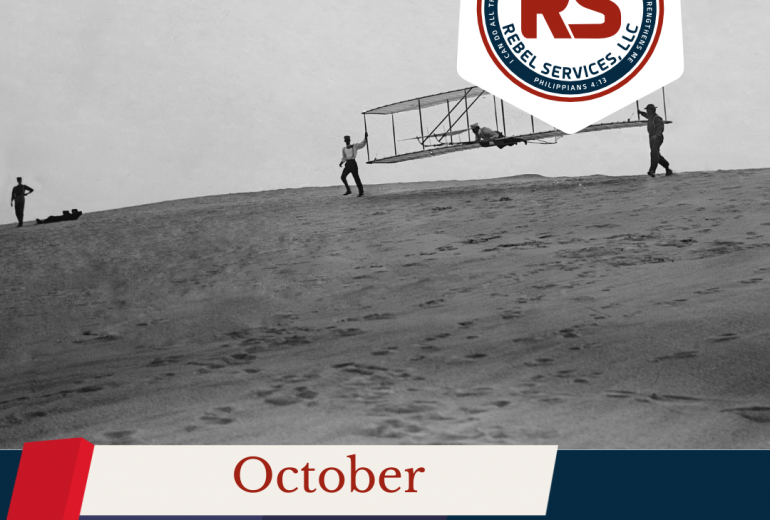Welcome back to another exciting month of Aviation History. How much about aviation’s historical background do you know? For instance, did you know that on October 1, 1861, the United States Balloon Corps was formed? It consisted of five balloons and fifty men. How interesting!
Here are some more interesting history of aviation facts.
Week of October 1-7
In 1947, on October 1, Los Angeles Airways opened the world’s first regular airmail service by helicopter. They used the Sikorsky S-51 machines for their operations.
On the fourth of October in 1957, Russia launched Earth’s first satellite. Sputnik weighed 184 lbs and attained an orbital velocity of five miles per second.
On October 5, 1905, Wilbur Wright made the first flight of over half an hour in the Flyer II at Simms Station, Ohio. Sixty years later on this date, the United States Air Force successfully launched an orbiting satellite.
In 1908 on the sixth of October, Wilbur Wright and a French writer made the first passenger flight that lasted over an hour in France.
On October 7, 1909, Glenn Curtiss became the first American to hold an FAI airplane certificate.
Week of October 8-14
In France, on the eighth of October in 1883, French brothers Albert and Gaston Tissandier made the first flight with an airship powered by electricity.
Also in France in 1890 on October 9, the first full-sized airplane which was manned left the ground under its own power. Frenchman Clement Ader’s airplane was a steam-powered, propeller-driven aircraft. On the same day in 1921, the “Flying Yacht”, a Loening Monoplane, flew 188 miles and 80 minutes from Aberdeen, Maryland to Port Washington, New York.
On October 11, 1910, U.S. President Teddy Roosevelt was the first United States President to fly when he was taken up in St. Louis. And, on this same date in 1958, the United States Air Force launched a lunar probe, the Pioneer I, which attained a height of approximately 80,000 miles.
In 1947, on October 14, Capt. Charles “Chuck” Yeager became the first person to fly faster than sound in Dry Lake, California. He broke the sound barrier in his Bell X-1 airplane, the “Glamorous Glennis”, which was named after his wife. He reached 670mph or Mach 1.015.
Week of October 15-21
On October 15, 1927, Capt. Dieudonne, from France, landed in Brazil and became the first person to fly nonstop across the South Atlantic. It took him over 18 hours to make the 2,100-mile flight. In 1929 on this same date, New York’s Mayor, Fiorella La Guardia, dedicated an entire airport in Flushing to bear his name. La Guardia was one of the costliest airports to build at the time, costing $45 million.
In 1908, on October 16, Samuel Cody became the first man to fly in Britain. Cody flew the British Army Aeroplane N°1 for 1,391ft before he crashed. And, on the same day in 1917, the final tests were made for the United States Army-designed air-to-air radio communication system with a wireless set. It achieved a distance of 25 miles.
Lieutenant V.C. Griffin, on the 17th of October in 1922, made the first take-off from the USS Langley—America’s first operational aircraft carrier—in a Vought VE-7SF airplane.
On October 18, 1909, Wilbur Wright’s very first aviation student, Charles Comte de Lambert, flew around the Eiffel Tower. Nineteen years later on this date, Fred Lund made the first outside loop in a commercial plane at the Advance Aircraft test field in Troy, Ohio. He was in a Sport Waco, which was a Wright Engine.
And, on October 21, 1970, the Martin X-24A aerospace vehicle made its first supersonic flight.
Week of October 22-31
In 1955, on October 22, the Republic F-105A called the Thunderchief, exceeded the speed of sound on its first flight.
And, on October 23, 1909, Lt. Benjamin D. Foulois took his first flying lesson from Wilbur Wright. Four days later, on the 27, of the same year, Mrs. Ralph van Denman flew for four minutes with Wilbur Wright at College Park, Maryland. This caused her to be the first female passenger in the United States. Also in 1909, on the 26 of October, Lt. F.E. Humphreys became the first Army officer to solo fly the first Army airplane.
On October 29, 1952, the Super Sabre, a North American Aviation F-100, set a speed record of 755.149mph over a 9.3-mile course.
The US Navy R4D-5, known as the Skytrain Que Sera Sera and commanded by Rear Admiral George Dufek, was the first airplane to make a landing at the South Pole.
That’s it for October’s aviation history month! Be sure to come back next month to see what happened in aviation during November!


